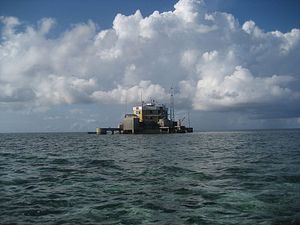China has taken a leap towards clarifying its claims in the South China Sea, but in a direction that could intensify frictions.
The International Tribunal on the Law of the Sea delivered a sweeping ruling Tuesday against China in an arbitration case initiated by the Philippines. The result significantly limits the size of the maritime zones and scope of maritime rights that China can legally claim. Minutes later, the Chinese government issued a statement. In it, China stakes claims to sovereignty over all land features in the South China Sea, as well as entitlement to internal waters, territorial sea, contiguous zone, the exclusive economic zone (EEZ) and continental shelf based on these islands, as well as historic rights in unspecified waters.
China’s previous position was more ambiguous. “China exerts indisputable sovereignty over the South China Sea Islands and the adjacent waters and…is entitled to relevant maritime rights and interests based on the South China Sea Islands as well as historic rights in these waters,” the foreign ministry said a few days before the ruling.
Rather than speaking of undefined rights and interests in undefined waters, Beijing has now adopted the language of the United Nations Convention on the Law of the Sea (UNCLOS) in naming the maritime zones it claims, although it does not plan to follow its spirit.
By claiming “internal waters” – those within a country’s territorial sea baseline — Beijing has sent a strong signal of its intention to treat the Spratlys as an archipelago, draw a baseline around it and claim the extended maritime zones outward. This is not new: China had revealed its hand days before the Tribunal’s verdict, when the foreign ministry said the island group, which China calls Nansha, “as a whole are entitled to territorial sea, exclusive economic zone, continental shelf and other maritime rights and interests.”
A normal baseline under UNCLOS “is the low-water line along the coast.” The convention also allows archipelagic states to draw straight baselines around “the outermost points of the outermost islands and drying reefs of the archipelago” that includes the main islands.
Should Beijing follow through by encircling the island chain in a straight baseline, it would directly contradict the Tribunal’s conclusion “that the Spratly Islands cannot generate maritime zones collectively as a unit.”
China has already drawn a straight baseline around the Paracel Islands, claimed also by Vietnam but controlled exclusively by China. A Chinese baseline around the Spratlys would enclose features occupied by other claimants. China controls seven of them; Vietnam controls 21; the Philippines holds nine; Malaysia five; and Taiwan one. According to UNCLOS, a state has complete sovereignty over its internal waters. It does allow for the right to innocent passage within a straight baseline around an archipelago. Would China, however, consider trips by resupply ships from rival claimants to Spratlys as innocent passage, which “shall be continuous and expeditious,” or would it take enforcement actions against them in its claimed internal waters?
A Chinese baseline around the Spratlys would be challenged by the United States. Washington already argues that Beijing may not draw an archipelagic straight baseline around the Paracel Islands because China does not meet UNCLOS’s definition of an archipelagic state. In January 2016, the U.S. sent a warship into the Paracels on a Freedom of Navigation operation. It would almost certainly contest a Spratly baseline with naval vessels as well.
With a baseline, China would claim a 200-nautical mile EEZ outward from it. That large swath of water could become a theater for dangerous encounters between the U.S. and Chinese militaries. The U.S. holds that military forces of all nations have high-seas freedom in EEZs and that prior notification or consent is not required from the coastal state for military activities. China insists that reconnaissance activities in its EEZ without prior notification and permission violate both domestic and international law, and has routinely intercepted U.S. reconnaissance flights and vessels. The different interpretations of rules have caused multiple close calls as well as a collision in 2001 between a U.S. EP-3 reconnaissance plane and a Chinese F-8 fighter jet that killed a Chinese pilot.
In its latest rendition of South China Sea claims, Beijing has yet to specific what constitutes its definition of historic rights or where it would claim those rights, leaving room perhaps for negotiations. It is also unclear whether China will claim an EEZ from the Scarborough Shoal, despite the Tribunal’s ruling that it is a “rock,” entitled to a twelve-nautical mile territorial sea but nothing more. China appears, however, to be hardening into a position of claiming the Spratlys collectively as an archipelago and asserting exclusive entitlement to the natural resources in a large area in the southern half of the South China Sea, rich in fisheries and hydrocarbon reserves, or a basis to regulate foreign military activities in those waters.
In principle, clarity from Beijing is welcome, but clarification can also mean calcification of positions. When China reveals its bottom line, can the rest of the world live with it?
Xie Yanmei is the Senior China Analyst of the International Crisis Group, the international conflict prevention organization.

































